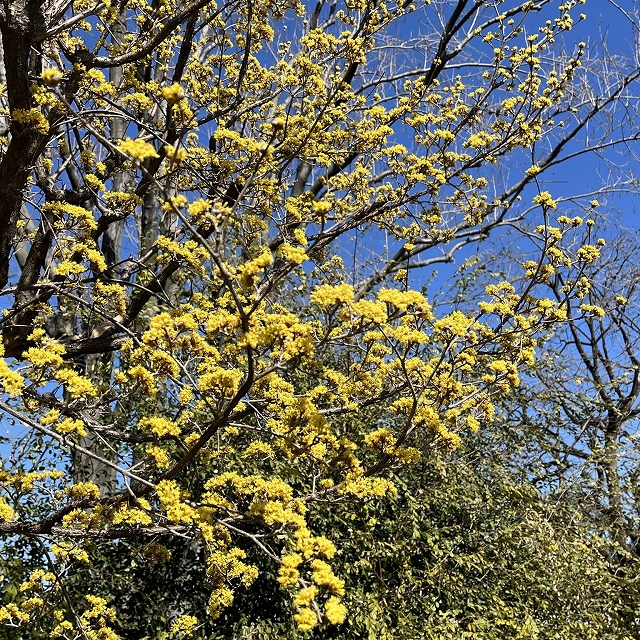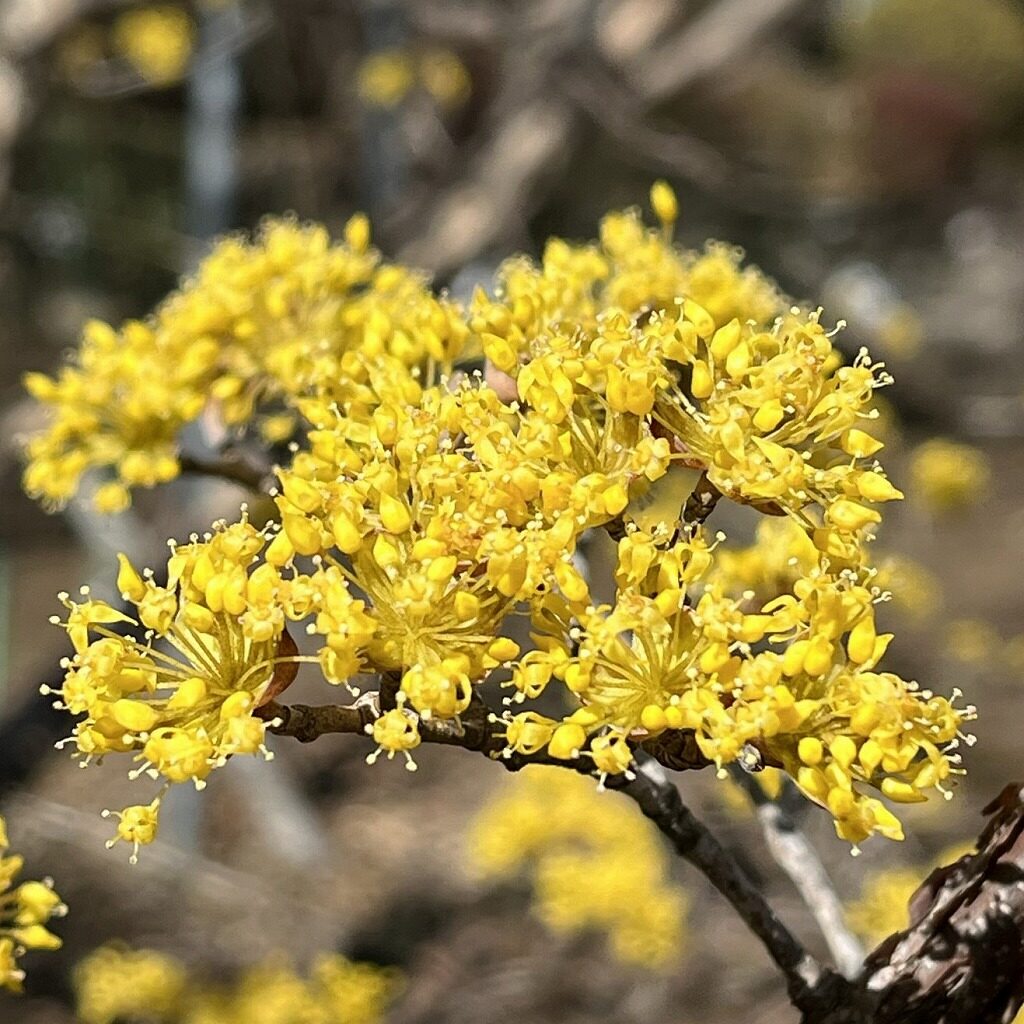サンシュユは樹皮が剥がれて趣きがあり、花は葉が展開する前に咲いて樹全体を金色に輝かせ、果実は紅葉とともに赤く艶やかに色づきます。
Japanese Cornel has an attractive taste because the bark of the trunk is peeled off, the flowers bloom before the leaves develop, making the whole tree shine with gold, and the fruits turn a glossy red with the autumn leaves.
【仮名】サンシュユ, ヤマグミ, ハルコガネバナ, アキサンゴ
【和名】山茱萸, 春黄金花, 秋珊瑚
【英名】Japanese Cornel, Asiatic Dogwood
【学名】Cornus officinalis
【誕生】01/ 18, 02/ 21, 03/ 17
【開花】02, 03, 04月
【花色】Yellow




サンシュユ
サンシュユの来歴
サンシュユはミズキ科の落葉小高木です。原産地は中国~朝鮮半島で、日本へは江戸時代に薬用で渡来。幹は樹皮が薄く剥がれて趣きがあり、花は葉が展開する前に咲いて樹全体を金色に輝かせ、果実は紅葉とともに赤く艶やかに色づきます。花言葉は「持続」「耐久」「強健」など。
サンシュユの名前
サンシュユの名前は漢名「山茱萸」の音読みで果実が「茱萸」に似ているから。訓読みも「やまぐみ」です。ラテン語の属名コルヌスは「角」という意味で材が堅いから。種小名オフィシナリスは「薬効のある」という意味です。別名の「春黄金花」は花に、「秋珊瑚」は果実に由来。
サンシュユの姿形
サンシュユの幹は灰色の樹皮が剥がれると褐色に。葉は枝先で対生し、先端の尖った楕円形で、裏に毛が生えます。花は小さく集まって咲き、花弁のような苞葉が反り返って4枚、雄しべが4本。果実は長楕円体の核果で縦に稜が入り、熟すと甘くなるものの、渋味と酸味があります。
サンシュユの薬用
サンシュユは漢方の生薬。熟した果実を用い、種子を除いて日に干します。成分はリンゴ酸、酒石酸、没食子酸など、作用は強精、強壮、収斂など。民間療法では果実を煎じたり、蒸留酒に漬けるなどして飲み、疲労回復、滋養強壮、低血圧、冷え症、不眠、頻尿などに用いられます。
サンシュユの近縁
サンシュユの近縁種「西洋山茱萸」は原産地が中欧~西アジア。英名で「コーネリアンチェリー」と呼ばれます。果実は熟すと甘く酸味があり、生食のほか、ジャムやジュースなどでも利用。カルシウムなどのミネラルも豊富で、昔から薬として腹痛、風邪、下痢にも用いられました。
Japanese Cornel
History of Japanese Cornel
Japanese Cornel is a deciduous small tree of Cornaceae family. The place of origin is from China to the Korean Peninsula, and it was brought to Japan for medicinal use in the Edo period. It has an attractive taste because the bark of the trunk is peeled off, the flowers bloom before the leaves develop, making the whole tree shine with gold, and the fruits turn a glossy red with the autumn leaves. The language of flowers is “persistence”, “durability”, “robustness”, etc.
Name of Japanese Cornel
The name of Japanese Cornel is derived from the Chinese, and means wild fructus because the fruit resembles fructus. The genus name Cornus in Latin means “horn” because of its hard wood. The species name Officinalis means “medicinal”. The other name “spring golden flower” is derived from the flower, and “autumn coral” is derived from the fruit.
Shape of Japanese Cornel
Japanese Cornel trunk turns brown when the gray bark is peeled off. The leaves are opposite at the tip of the branch, oval with a pointed tip, and hairy on the underside. The flowers bloom in small clusters, with 4 recurved petal-like bracts and 4 stamens. The fruit is an oblong drupe with vertical ridges, and although it becomes sweet when ripe, it has an astringent and sour taste.
Use of Japanese Cornel
Japanese Cornel is a herbal medicine. Use the ripe fruit, remove the seeds and dry in the sun. Ingredients include malic acid, tartaric acid, gallic acid, etc., and its effects include tonic and astringent. In folk remedies, the fruits are boiled or soaked in distilled liquor, and used for recovery from fatigue, nutritional tonic, hypotension, sensitivity to cold, insomnia, and frequent urination.
Relatives of Japanese Cornel
A related species of Japanese Cornel, “Cornelian Cherry”, originates from Central Europe to West Asia. Its fruit has a sweet and sour taste when ripe, and is used not only for eating raw but also for jams and juices. Rich in minerals such as calcium, it has long been used as a medicine for abdominal pain, colds, and diarrhea.


